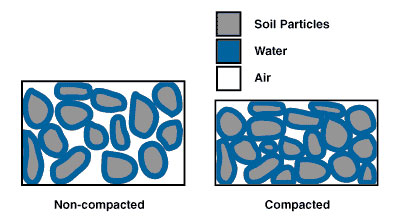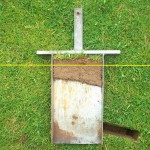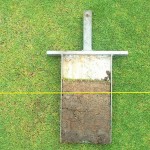I once smugly commented that there were only two main problems in bowling green maintenance, thatch and compaction and that everything else that goes wrong is simply a symptom of one or other of these.
Well, you know that is still broadly true, but it depends where you start. You see bowling green maintenance is a circular argument; there’s no real start or finish point in greenkeeping, it’s a continuous process that starts somewhere back in time before the green was even built and finishes…well…somewhere after we’re all feeding the microbes I suppose 🙂
In this respect, even thatch and compaction are symptoms of something else. The reason I say that is due to the realisation over 30+ years of observing turf of all sorts, both the completely naturally occurring and the completely manufactured.
And here is what I’ve found:
In the most natural fine turf settings like on the links land near the coast or the Machair, there’s no compaction and very little thatch. I’ve also observed this same effect on a multitude of golf courses including some municipal, city centre courses built on heavy soil where I expected to find compaction and thatch in abundance. In an earlier article, I reported that even on sites such as this there is a direct correlation between the intensity of maintenance (greenkeeping) and the density and propensity of thatch. And it’s the opposite to what intuition might tell you.
Have a look at these soil samples from such a golf course:
The photos show 3 soil profile samples from a 10 metre radius of ground taking in part of a green, part of a fairway and part of a rough area on the golf course in question. They show that thatch is a human problem, usually resulting from intensive maintenance. The less we do to the turf, the fewer problems we encounter, but of course we can’t just leave a bowling green to look after itself and expect a fine bowling surface, but this demonstrates the essence of disturbance theory in action.
Thatch, is the build up of dead plant (leaves, roots and shoots of grass plants) material that accumulates at the turf surface and instead of being an encumbrance to wild and natural turf such as the links and machair lands, it is an essential resource that is converted (recycled) into humus (fully decomposed organic matter) by soil organisms and micro organisms. In a natural grassland the recycling would keep up with thatch production just as we see in the sample from the golf rough above. The humus produced becomes a key resource in the Cation Exchange Capacity of the soil and the process of recycling is a key part of the Nitrogen cycle that provides this most essential of nutrients to the grass plants.
But why doesn’t it just happen naturally in our bowling greens?
The simple answer is Compaction. However, there are other factors at play such as our sloppy use of sand and fungicides which disrupt the natural processes too.
What is Bowls Green Compaction?

Simply put, Compaction is the squeezing together of the soil particles resulting in the reduction in air space (Macro Porosity) in the soil. From our earlier study, we learned that the Macro Pores in the soil are responsible for two key factors in soil health, soil aeration and drainage. When the soil is compacted both of these are compromised. The soil becomes wetter and less easy to manage and the oxygen supply needed to support a healthy population of aerobic microbes is reduced resulting in a build up of un-decomposed thatch at the green surface. Nitrogen supply is also interrupted so we are tempted to use more fertiliser which has the effect of making the grass soft and lush and more susceptible to disease pathogens. MIcrobes aren’t around to convert some of the fertiliser to plant useable forms and roots are curtailed due to the compaction anyway. The thatch becomes thick, spongy and wet which creates a niche at the turf surface that favours pathogenic fungi like fusarium. So, we spray fungicides to kill the disease, but we also kill beneficial fungi. Annual meadow grass sees a chance in the gaps caused by the disease and so begins the Circle of Decline in fine turf.
Compaction then at its simplest is just the squeezing down of the soil by foot and maintenance traffic. Left unattended it will get worse until there are hard layers (pans) below our green. We might be tempted to treat the symptoms of compaction by doing some severe form of aeration that might disturb play for the rest of the season. We might sack the greenkeeper or contractor as a result of that. Next year we’ll try another miracle cure for the symptoms.
That brings me full circle to where I started this article. Thatch and Compaction are really no more the cause of bad greens than anything else. They are simply symptoms of the commonly used reactive (symptoms management) approach to greenkeeping. They are symptoms of bad green management and to get past that and onto producing consistently high performing bowling surfaces, we need to start thinking of the bowling green as an eco-system and working proactively to maintain the balance within the system whilst manipulating it a little to provide us with the surface we need for bowling.
If greenkeeping is a circular argument, then where do we start in the improvement of a bad green? The answer is anywhere; you can break into the circle of decline and start to turn it around at any place and at any time. It’s just a matter of knowing what to do and when it should be done. There’s no need to wait until the end of the season.
Next time we’ll start to do just that. Any comments or questions? Use the space below to let me know.





hi John recently came into possession of a bannerman aerator. have you come across one and do they work.
A person who helps and supplies our fert etc is trying get me to top dress the green and i am resisting so that i can see next season if the green survives ok. What do you think.
Hi Terry
I don’t have any experience of using the Bannerman machine, but had a quick look here and they look like reasonable machines.
I have no doubt that your green will survive if you miss out the top-dressing, but the decision should be made based on your observations of the green. Some guidance here:
https://bowls-central.co.uk/green-keeping/fix-your-bowling-green-step1
https://bowls-central.co.uk/green-keeping/fix-your-bowling-green-step-2
https://bowls-central.co.uk/green-keeping/fix-your-bowling-green-step-3
Let me know what you find.
John
John,
I am a novice of three years looking after our green in Crosby. We scarify every year in September, top dress and seed. We spray liquid iron to kill off the moss at the end of October. We have quite a few areas where we cannot get the grass to grow. we seed these areas again in March but to no avail. a sample taken by our supplier indicated compact ground. we have spiked the entire green to let the air and water in but recent inspections of the compacted ground, shows no growth again. Can you advise what to do. some suggestions from people who think they know a lot about greens say we will need to dig up the areas, replace with good quality soil and seed. Not sure about that though.
Hi David
It’s hard to advise you with so little to go on. Could you send me some more detailed information based on the guidance in these articles please?:
Fix your green step 1
Fix your green step 2
fix your green step 3
If you can send photos of any problem areas on the surface and also of soil profile samples that would be great. Also if you have a recent soil analysis report, I’d be happy to look over that and make recommendations.
Regards
John
John,
Thanks for replying, we are taking soil samples for analysis first week in November and I will advise the results to you as soon as we receive them. I will take some photographs of the problem areas for you to view.
hi john
we have a machine called a planetaire, that spikes our greens. it is done on a weekly basis with no disruption to the playability of the surface. it is a great equalizer for thatch control and also aids in getting the micorrhiza and trichoderma into the rootzone. the frequent use of greens rollers to increase speed is a detriment to everything else we need to do